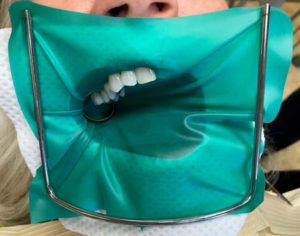Rubber Dam – An Important Dental Tool
Not every dentist uses a rubber dam when performing dental procedures on patients. Not all patients understand what rubber dams are or why they are used. In fact, I had a patient in the office yesterday who recently transferred from another office. She had no idea what I was doing when I started preparing the rubber dam for placement in her mouth. I hope that by the time you finish reading this blog post, you understand why I think they are an important tool in our office.
Rubber Dam Description

A rubber dam applied over a patient’s mouth
This photo shows a patient with a rubber dam in place. We take a 5×5 or 6×6 sheet of latex or nitrile (non-latex) material and place it over the tooth or teeth to be worked on. Holes are punched in the material. We then use floss to work the material in between each tooth to be worked on. A clamp is placed on the most rear tooth to hold the material down, and a napkin is then placed between dam and the skin. As you can see in the photo, we then attach the edges of the dam to a metal frame to hold it in place.
Why Don’t All Dentists Use Rubber Dams?
Dentists are trained (not very well I might add) how to use rubber dams in dental school. Like many others, when I first graduated from dental school, I thought they were too cumbersome and time-consuming to use on a regular basis.
When I started participating in my first study club, however, the mentor of our club showed us younger dentists how to properly place a rubber dam. Finally, I understood that they can be placed efficiently and effectively. From that point, I began using rubber dams consistently with my patients.
Why Should Rubber Dams Be Used?
If I am placing a small filling towards the front of the mouth, I may not use a rubber dam. However, any time I am working on a tooth towards the back of the mouth, I use a rubber dam. I use it to isolate the quadrant of the mouth that I am working on. In my opinion, the main advantages to using a dental dam are:
- Visibility – I see nothing but the section of the teeth I am working on.
- It creates a clean, dry field for me to do my work.
- There is no contamination of the field with saliva. This is particularly important with tooth colored fillings, which are technique sensitive. Saliva can compromise the bonding process of the composite material to the remaining tooth.
- The patient does not swallow any old fillings (if we are removing old restorations) or water from the hand pieces.
- It protects the soft tissue of the tongue and cheeks and keeps them out of the way.
- When performing root canals, the rubber dam provides protection to the cheeks and tongue from the rinse we use (usually bleach) when cleaning out the tooth canals.
- Small files are used during root canals. A rubber dams ensures that a dropped file does not enter a patient’s throat.
Rubber dams do require some additional time to place. However, when I look at time spent to do this and weigh it against the increased protection for my patients, patient safety wins. Furthermore, when I consider the ability it gives me to do better work, it’s pretty clear. The benefits of using rubber dams far outweigh any disadvantages.
